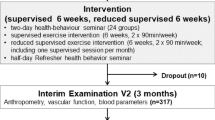Abstract
The greatest danger to the future of human life is Man. Environmental issues are becoming highly topical, with attention focusing on nuclear power plants and their operational hazards. The main concern tends to be their technological reliability rather than the fact that humans are in control. In its long-term research project, the Institute of Sports Medicine, which belongs to the 1st Medical School of Charles University in Prague, is primarily concerned with examinations of the most exposed workers in nuclear and thermal power plants. As all of them are under supervision of their plant physicians, the purpose of the project is to uncover possible hidden health hazards that could result in a sudden collapse of the person concerned and bring about a disaster with far-reaching consequences. This paper presents only a small fraction of the results obtained to date. In functional anthropology and functional exercise dianostics we focused on certain signs that could be interpreted as risk factors for cardiopulmonary failure especially due to CHD, frequently found in middle-aged men. We also discuss the changes that have taken place in the 76 investigated nuclear power plant operators and managers during the three-year observation period.
Our methods included basic anthropological and clinical examinations, determination of body composition and of the primary and secondary somatotype components, spirography, ergometry on a bicycle ergometer, haematology and biochemistry, in the first place of serum lipids.
Although the work performance of the men investigated was high, our results have in some cases indicated certain hazards. For every test person we drew up a specific regimen—nutrition, movement and when required, therapy—and gave it to the plant physician. The management provided for men with such risk factors (a specific form of regeneration). Regular annual check-ups revealed in the men who complied with the prescribed regimen a noticeable decrease of risk factors and their increase in the men who did not comply. For such persons we recommended a professionally controlled form of regeneration and supervision of their movement regimen. The research, which will continue for some time yet, highlights the fact that as much attention should be paid to the human factor as to the technological safety of nuclear power plants.
Similar content being viewed by others
References
Bradejsky P., Baránčková M., Boudová L. and Novotný v. Some indicators of functional fitness of middle-aged men with different physical activities. (in Czech) In: Celostátní sjezd telovych. lákarštví, Brono: KÚZ, 1988: 161–6.
Cooper K.H., Pollock M.L. and Martin R.P. et al., Physical fitness vs. selected risk factors. J.A.M.A. 1976; 236:166–9.
Cowan G.O.. Influence of exercise on high-density lipoproteins. Am. J. Cardiol. 1983; 52:138–68.
Hainer V., 4th Europa Congress en of obesity (in Czech) Čas. Lék. Čes. 1992; 131:682–4.
Hollmann W. and Rost R., Function und Leistungsgrenzen des meschlichen Herzens. Dtsch. Z. Spormed. 1987; 38:231–6.
Holloszy H.O., Adaptations of muscular tissue to training. Progr. cardiovasc. Dis. 1976; 18:445–458.
Larson, B., Fat distribution and risk of death, miocardial infraction and stroke. In: Fat Distribution During Growth and Later Health Outcomes. Alan R. Liss Inc. 1988: 193–201.
Neumann G. and Biermann J. Zur Dosierung der Ausdauerbelastungen für die Prävention von Stoffwechselstörungen. Med. Sport (Berlin) 1986; 26:13–6.
Novotný A. and Kadečkvá R. Contribution to cigarette smoking and physical fitness. (in Czech) Lék. těl Vych. 1990; 18:77–83.
Novotný V., Brandejský, P. and Boudová L. et al., Differences in the impact of power and endurace exercises on body composition and the cardiovascular system of young men. (in Czech) Sb. Čs. spol. atropol., Brno, in press.
Pfisterer M.E., Sport, körperliche Aktivität und koronares Risiko. Zschr. Kardiol. 1981: 70:104–110.
Sallis J. et al., Physical activity assessment methodology in the five-city project. Am. J. Epidemiol. 1985; 121: 91–106.
Seliger V. and Bartûněk Z., Mean values of various indices of physical fitness, in the investigation of Czekoslovak population age 12–55 years. Praha: CSTV 1976:117.
Stamford B.A. et al., Cigarette smoking, exercise and high-density lipoprotein cholesterol. Atherosclerosis 1984; 52:73–83.
Strauzenberg S.E., Ausdauerübungen in der Prävention und Therapie von Stoffwechselstrungen. Med. Sport. (Berlin) 1980; 20:162–8.
Widimský J., Physical training and CHD. (in Czeck) Lék. těl. Vých. 1985; 13:42–9
Zaciorskij V.M., Movement activity-anti-risk factor of CHD, (in Russian) Těor. Prakt. fiz. Kult. 1986; 34:44–53.
Author information
Authors and Affiliations
Rights and permissions
About this article
Cite this article
Novotný, V.V., Brandejský, P., Boudová, L. et al. Preventive examinations of nuclear power plant operators and managers — Anthropological and medical research project. Int. J. Anthropol. 9, 21–33 (1994). https://doi.org/10.1007/BF02442182
Issue Date:
DOI: https://doi.org/10.1007/BF02442182




